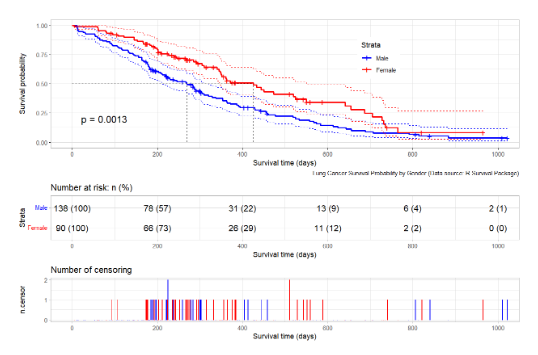Time series/Longitudinal data analysis
- Home
- Services
- TSLDA
Overview
Survival analysis studies the amount of time it takes before a particular event of interest occurs. It plays a pivotal role in statistical modeling, especially in business, medicine, biology and reliability studies where time-to-event data is fundamental.
What types of questions can be answered with survival analysis?
- What is the probability of experiencing an adverse outcome from a specific cause by a given time?
- Does a specific intervention reduce adverse outcomes for all causes or just for specific ones?
- On average, how long after an intervention/treatment/procedure do different groups experience some specific adverse outcome?

What types of models can we implement at oores Analytics?
- Kaplan-Meier survival curve with confidence intervals and confidence bands,
- Wilcoxon, log-rank test,
- Kernel-Smoothed Hazard Estimator,
- Cox Proportional Hazards Models,
- Competing Risks Analysis
At oores Analytics, we have the tools necessary to analyze and interpret time-to-event data within a rigorous stochastic framework. Talk to us and see how we can help you harness the power of your data, translating same into real-world scenarios, and thus enable you make data-driven decisions!

Case studies
See our case studies about data analyst case
Overview
Time series/longitudinal data analysis involves methods for analyzing data collected over time from the same subjects or units. While both deal with data measured across time, they differ slightly:
- Time Series Analysis: Focuses on a single subject or system over time (e.g., monthly sales data for a company).
- Longitudinal Analysis: Involves multiple subjects observed repeatedly over time (e.g., patient health measurements across several visits).

Our time series/longitudinal data expertise includes:
- Understanding the data structure
- time series: one unit over continuous time (e.g., daily temperature readings)
- Longitudinal: repeated measures across individuals (e.g., weight measured monthly in a clinical trial)
- Exploratory Data Analysis (EDA)
- Visualize trends, seasonality, irregularities
- Plot individual and group trajectories
- Check for missing values and outliers
- Assessing Stationarity (for time series)
- Modeling approaches
- Address correlation over time
- Account for autocorrelation
- Use lag structures, random effects, or correlation matrices
- Model diagnostics
- check residuals for patterns
- evaluate goodness-of-fit (AIC/BIC)
- cross-validation or forecasting accuracy (e.g., RMSE, MAE)
- Prediction & forecasting
- Generate short- or long-term forecasts
- Include uncertainty bounds
- Scenario modeling and intervention analysis (e.g., impact of a policy)
- Understanding the data structure
What types of questions can be answered with time series/longitudinal data?
Time series
- (Trends, seasonal patterns) How do monthly hospital admissions vary over 12 months?
- (Forecast/predict future values) What will the COVID 19 case count be next month?
- (Short- and long-term cycles in the data) Are there economic cycles in quarterly health spending?
Longitudinal
- (Individual or groups change over time) How does BMI change over 10 years in patients with Type II diabetes?
- (Time-varying and fixed covariates influence outcomes) Does stress level (measured monthly) predict future depressive symptoms?
- (Differences in change across subgroups) Do treatment and control groups show different recovery trajectories?
- (model individual growth or decline) What is the rate of cognitive decline by age and education level?
What time series/longitudinal data models can we implement at oores Analytics?
Time Series Models
- ARIMA (AutoRegressive Integrated Moving Average)
- Exponential Smoothing (ETS)
- Seasonal models (SARIMA)
- State space models/Kalman filters
- Prophet (for irregular time series)
Longitudinal/Panel Data Models
- Linear Mixed Effect Models (LMM)
- Generalized Estimating Equations (GEE)
- Growth curve models
- Multilevel/hierarchical models, Regression trees
- Survival analysis (for time-to-event outcomes)
At oores Analytics, we have the tools necessary to analyze and interpret time series/longitudinal data. Talk to us and see how we can help you harness the power of your data, translating same into real-world scenarios, and thus enable you make data-driven decisions!
